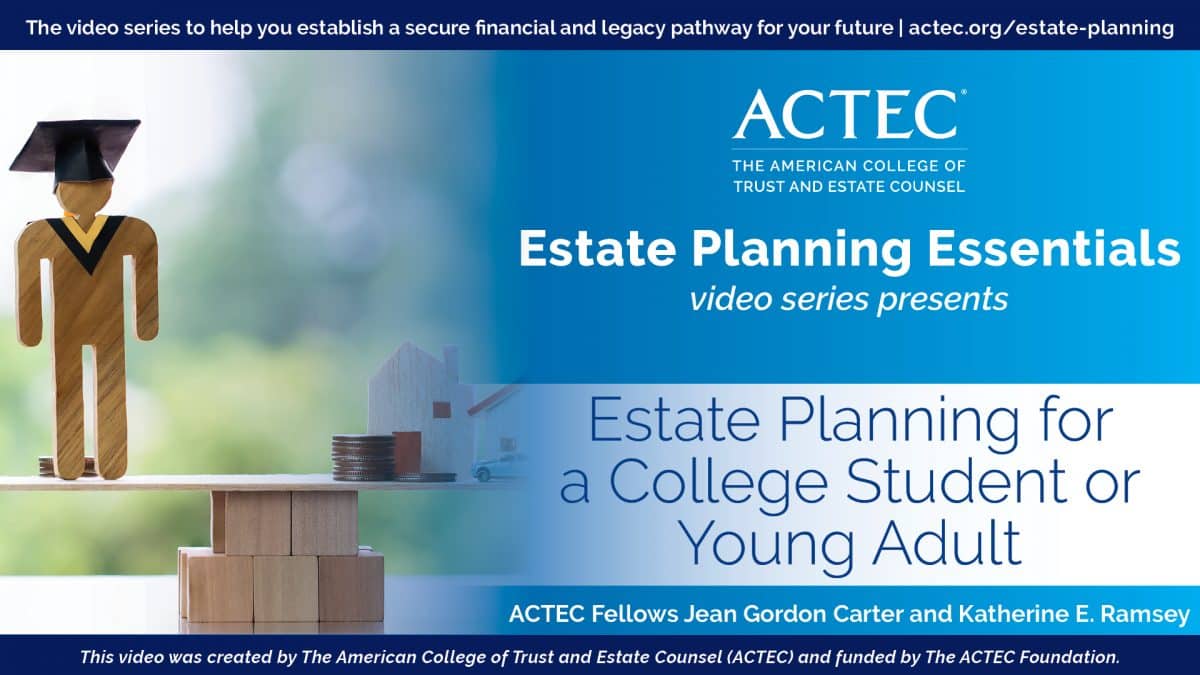Learn what you need to know about 529 Plans and saving for educational purposes, including what to keep in mind when choosing a plan, how to pick a successor account owner, how to use the distributions, how to manage the expenses, and what to do if you have leftover money.
ACTEC Fellows Susan T. Bart and Stacy E. Singer answer the questions parents and families have about how 529 Plans work and what you need to keep in mind when saving for higher education.
Resources
Transcript
Hi, I’m Stacy Singer, an ACTEC Fellow from Chicago, Illinois, and I’m here with Susan Bart, an ACTEC Fellow, also from Chicago, Illinois, and we’re here to talk about 529 pros and cons. Susan, thanks so much for being here, and let’s start with the basic.
529 Plan Considerations
So, why should I consider using a 529 plan?
Susan Bart: Stacy, if you have children or grandchildren or favorite nieces and nephews who will be going to college, a 529 account can really be a great way to save for a college education. There is no federal income tax and usually no state income tax imposed as the funds grow in the account. And when you pull the funds out, as long as they’re used for qualified higher education expenses, there’s no federal income tax on the distribution and often no state income tax. 529 accounts also receive some favorable treatment for financial aid purposes, so they’re really a great way to save for college education.
Selecting 529 Plan Tips
Stacy Singer: So, this sounds like a great idea. So, what’s important to consider when I’m selecting a 529 plan? Is there just one plan?
Susan Bart: That can be a tough question because there are so many plans out there. Virtually every state has a 529 plan, and some of the states have multiple 529 plans that you can select from. And there are some resources out there, like Morningstar, that can help you compare the plans.
What I look for, first of all, is low fees, because high fees can really cut into your net return. Second thing I look for is a plan that has strong investment options that you like, and I also like to look for a plan that has an investment option that you really don’t have to fuss much with. You can select it and just let it ride, and for many of those plans, those are called age-based portfolios, and that’s where the portfolio automatically- without you having to do anything- will, as the beneficiary gets older, adjust to be less risky. So, as the beneficiary ages, they’ll basically put more in bonds for similar investments and less in equities so that you don’t have a large investment fluctuation right on the eve of the beneficiary going to college.
I also like- and the plans have this- is the automatic contribution option, where you can just set it up so that every month, right out of your paycheck or right out of your savings account, a certain amount will automatically go into the 529 account.
Tips for Setting up a 529 Plan Account – 529 Account Owner
Stacy Singer: Those sound like great suggestions. So, what do I have to think about when I’m setting up an account?
Susan Bart: These are very easy to set up. You can set them up the old-fashioned way, with paper, but you can also set them up electronically. One thing you want to think about is, who is the account owner, and who’s the successor account owner? And that’s very important, because 529 gives very broad powers to the account owner. That account owner is the one who can make distributions for the beneficiary’s education, they can change the beneficiary, and they also can actually take the money out of the 529 account and keep it for themselves.
Now, they may incur some tax or penalties, but you want to be really careful that whoever the account owner is and whoever the successor account owner is, is going to be a person who has your same goals for funding the education of the beneficiary, or if you have more than one account, the beneficiaries in the family. So, you’ve got a couple of daughters, you probably are very comfortable being the account owner on your own 529 accounts. But you have to think hard about who would be the successor if something happened to you.
529 Plan Payments and Distributions
Stacy Singer: That’s a great question, something I will have to think about, actually. So, tell me, can I only use 529s to pay for college expenses? Can I use them for primary education or other expenses?
Susan Bart: 529, in the Internal Revenue Code, has been expanded over the years to permit distributions for some things other than qualified higher education expenses, some things other than college. You can use it for primary and religious schools. There’s a limited amount that can be used to pay back student loans, a total of $10,000 for the beneficiary or the beneficiary’s siblings. You can use 529 account funds for vocational schools and now even for apprenticeship programs.
But my advice would be, until you know you have enough in that account to pay for the college education of the beneficiary, you really don’t want to touch it for any other purposes. So, you don’t want to be using it to pay for primary school because you want to make sure that you have enough in that account for the beneficiary’s college education and perhaps even their graduate school education, if that seems to be the direction in which they’re headed.
Recording Expenses and Tips When Using a 529 Plan
Stacy Singer: Got it, okay. So, what should I keep in mind when I’m actually going to be using the 529 for my kids?
Susan Bart: When you’re about to use it, that is a good time to get some good, professional advice about both what are qualified higher education expenses, so that you don’t accidentally pay for an expense that is going to trigger income tax; as well as if the beneficiary’s receiving financial aid, what is the best timing on withdrawing from the 529 plan? Those can both be very complicated questions to answer. Qualified education expenses are going to of course include tuition and required books and supplies for the student’s education, and a limited amount of room and board, basically, limited to what it would cost them to live on campus at the school, so you want to be very careful that all of your distributions are for qualified higher education expenses, you want to keep receipts. It’s a pain, but if the IRS comes and looks at your return, they may ask you to prove that all of the expenses have been for qualified higher education expenses. You also want to watch out if any of your expenses are counting against other educational credits. The rules generally will not allow you to double dip.
So, another reason to get some advice as your beneficiary starts off at school. And I mentioned the timing. You also want to check, sometimes if there’s not enough in the 529 account to use for all four years of education and there’s financial aid, you may want to time the use of the 529 account to use it in later years, because it will have less of an adverse impact on the financial aid qualification.
What Can You Do With Leftover 529 Funds
Stacy Singer: So, let’s say I’ve been great at saving money, and I have some money leftover when both of my kids get out of college. So, what can I do with the money that’s left?
Susan Bart: When your daughters graduate from college, let’s celebrate. Let’s pop a bottle of champagne. You’ve gotten them through and launched them into life. First question would be, are your daughters going onto grad school? Might they be able to use the excess money for that? Now, second question would be, if your eldest daughter graduates, do you want to change the beneficiary to the younger daughter?
Maybe she’ll need more funds, or maybe she has graduate school ambitions. And you can change the beneficiary on the 529 accounts so long as it’s a beneficiary in the same generation and the new beneficiary is a family member of the old beneficiary. Those are technical rules. It’s best to get some professional advice on it. You can change the beneficiary down to younger generations, even wait a few years and see if your daughters have children of their own. Now, there are some tax considerations in changing the beneficiary down a generation, so you want to get some professional advice.
You also, that might be a time to think about, if you had some younger children like I know you must be thinking about, you’ve launched these two, why not adopt a younger child? But you could think about paying for primary school for other beneficiaries in the family, and in the worst case, you’ve gone through all those options, there’s still excess money, you can make a distribution out to the beneficiary or out to the account owner, and you will pay some income tax on the earnings on the account, and you’ll pay some penalty tax on the earnings in most cases if you use the account just to make a payment out to the beneficiary of the account owner that’s not for any other permissible expenses under section 529.
Stacy Singer: Susan, thank you. This was so helpful. I so appreciate your advice. I think you’ve given us a lot to think about and work with as we work with 529 plans.
Susan Bart: Thank you very much, Stacy.
Featured Video
Estate Planning for a College Student or Young Adult
Understand what documents you should discuss and prepare for your college-bound and young adult when they turn 18, a legal adult.
ACTEC Estate Planning Essentials

ACTEC Fellows provide answers to frequently asked trust and estate planning questions in this video series.



